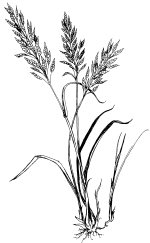
Removing Invasive Species
Prairie and savanna are both threatened by invasive species. Efforts to control the most problematic species have been undertaken at the Koester Prairie site since 2009. Current efforts involve the Minnesota Department of Natural Resources, the Cannon River Watershed Partnership, and other volunteers.

Wild Parsnip
Found along moving tracks and moist prairie land, this plant stands 3 to 4 feet or higher when mature, and produces a rosette of yellow flowers. It has a single taproot, like a carrot, but the plant also has a toxic sap. When the sap comes in contact with the skin, and is exposed to sunlight, it creates a severe rash and blistering. Complete eradication of wild parsnip from the site is imperative. Methods include targeted spraying in the late spring, mowing of larger populations, and hand pulling.
Buckthorn
This woody shrub spreads aggressively and crowds out native species. Commonly found beneath forest canopy, on the edge of the forest, or in complete sunlight. Methods of control include cutting and chemically treating the stems, and the use of prescribed burning.
Queen Anne's Lace
This plant stands 3 to 4 feet high when mature. Its white blossoms appear on an umbrella-shaped head. As a member of the carrot family, it too has a single taproot, which smells like a carrot. The plant spreads rapidly and creates dense stands that take over areas from other species, especially along mowing tracks and most prairie land. Control methods include broadcast spraying of especially problematic areas, as well as hand-pulling on selected sites.

Garlic Mustard
This plant has distinct single stems 12 to 36 inches high during flowering year and an onion or garlic smell when leaves and stems are crushed. Garlic mustard spreads in woody areas and takes over herbaceous cover. Control methods includes broadcast spraying when native plants are dormant, prescribed burning, and pulling in areas of light infestations.





